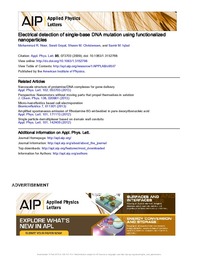
ATTENTION: The works hosted here are being migrated to a new repository that will consolidate resources, improve discoverability, and better show UTA's research impact on the global community. We will update authors as the migration progresses. Please see MavMatrix for more information.
Show simple item record
| dc.contributor.author | Iqbal, Samir M. | |
| dc.contributor.author | Christensen, Shawn | |
| dc.contributor.author | Goyal, Swati | |
| dc.contributor.author | Noor, Mohammud R. | |
| dc.date.accessioned | 2013-02-13T20:23:18Z | |
| dc.date.available | 2013-02-13T20:23:18Z | |
| dc.date.issued | 2009-08-17 | |
| dc.identifier.citation | Published in Virtual Journal of Nanoscale Science & Technology, vol 20, no. 9 | en_US |
| dc.identifier.uri | http://hdl.handle.net/10106/11311 | |
| dc.description.abstract | We report an electrical scheme to detect specific DNA. Engineered hairpin probe DNA are immobilized on a silicon chip between gold nanoelectrodes. Hybridization of target DNA to the hairpin melts the stem nucleotides. Gold nanoparticle-conjugated universal reporter sequence detects the open hairpins by annealing to the exposed stem nucleotides. The gold nanoparticles increase charge conduction between the electrodes. Specifically, we report on a hairpin probe designed to detect a medically relevant mutant form of the K-ras oncogene. Direct current measurements show three orders of magnitude increase in conductivity for as low as 2 fmol of target molecules | en_US |
| dc.language.iso | en_US | en_US |
| dc.publisher | Copyright American Physical Society, | en_US |
| dc.subject | Annealing | en_US |
| dc.subject | Bioelectric phenomena | en_US |
| dc.subject | DNA | en_US |
| dc.subject | Molecular biophysics | en_US |
| dc.subject | Nanobiotechnology | en_US |
| dc.subject | Nanoparticles | en_US |
| dc.subject | Mutations | en_US |
| dc.title | Electrical detection of single-base DNA mutation using functionalized nanoparticles | en_US |
| dc.type | Article | en_US |
| dc.publisher.department | Department of Electrical Engineering, The University of Texas at Arlington | en |
| dc.identifier.externalLinkDescription | The original publication is available at Article DOI | en_US |
| dc.identifier.doi | http://dx.doi.org/10.1063/1.3152768 | |
Files in this item
- Name:
- ApplPhysLett_95_073703.pdf
- Size:
- 567.7Kb
- Format:
- PDF
- Description:
- PDF
This item appears in the following Collection(s)
Show simple item record


